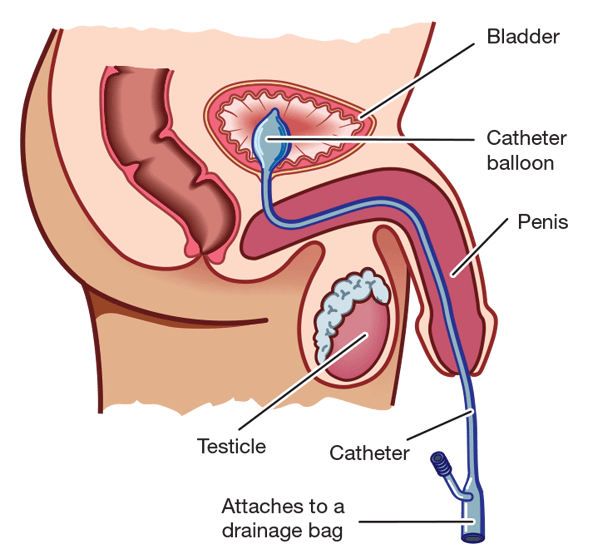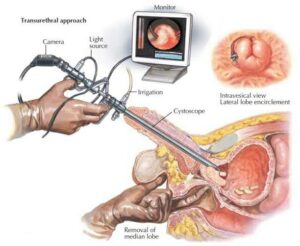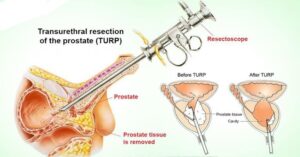Prostate Surgery
Prostate Surgery

Prostate surgery is commonly performed for two reasons: prostate cancer and benign prostatic hypertrophy (BPH). Treatment may be life-saving, or it may be done to relieve problems urinating that did not respond to medication.
Deciding on a prostate procedure can be difficult as there are multiple types available for the treatment of prostate issues. Each surgery has unique benefits and risks. Some of the less invasive procedures have a quicker recovery time, but they are not appropriate for the treatment of cancer. The more invasive procedures can cause long-term complications, but those issues must be weighed against the risk of leaving prostate cancer untreated.
Your choice of the surgeon may be the most important decision you make, even more so than the type of procedure. The more skilled the surgeon, preferably with extensive experience performing hundreds or even thousands of procedures just like yours, the less likely you are to experience erectile dysfunction due to nerve damage.
In addition to selecting a highly skilled surgeon, it is important to work with your surgeon to select the best procedure for your unique needs. Some procedures are used to shrink prostate tissue, others remove a portion or all of the prostate and may be used to treat cancer.
Enlarged Prostate or Benign Prostatic Hyperplasia (BPH)
The prostate is a small organ about the size of a walnut. It lies below the bladder (where urine is stored) and surrounds the urethra (the tube that carries urine from the bladder). The prostate makes a fluid that helps to nourish sperm as part of the semen (ejaculatory fluid).
Benign prostatic hyperplasia (BPH) is nonmalignant (noncancerous) enlargement of the prostate gland, a common occurrence in older men. It is also known as benign prostatic hyperplasia (BPH).
Signs and Symptoms of Enlarged Prostate or Benign Prostatic Hyperplasia:
The severity of signs and symptoms in people who have Benign Prostatic Hyperplasia or prostate gland enlargement differs, but the effect tends to gradually worsen over time. Common symptoms of prostate gland enlargement include:
- Difficulty in urination
- Frequent urge to urinate
- Weak urine stream. It gradually starts and stops
- Nocturia (increased frequency of urination during nights)
- Unable to completely empty the bladder
- Dribbling at the end of urination
- Blood in urine
- Inability to urinate
- Urinary tract infections
- Bladder damage
- Bladder stones
- Kidney damage
Diagnosis of Enlarged Prostate or Benign Prostatic Hyperplasia:
- Digital rectal exam: the doctor checks the rectum for determining prostate enlargement
- Prostate-Specific Antigen (PSA) blood test
- Urine test: for detecting any kind of infection
- Transrectal ultrasound
- Urodynamic and Pressure Flow Studies: This test measures your bladder pressure and determines how efficiently your bladder muscles are functioning
- Cystoscopy: this procedure is done to examine your bladder and urethra. The doctor will give you a local anesthetic before performing this test
- Prostate biopsy: This is done to check any signs on prostate cancer
- Surgeries for prostate :


- 1) TURP – ‘Gold standard’ surgery
2) Bipolar transurethral resection of the prostate: the new ‘gold standard’ method of resection of prostate
3) Laser surgery – Holmium laser prostate surgery is a minimally invasive treatment for an enlarged prostate. Also called holmium laser enucleation of the prostate (HoLEP), the procedure uses a laser to remove tissue that is blocking urine flow through the prostate.
TURP
Transurethral resection of the prostate (TURP) is a surgery used to treat urinary problems that are caused by an enlarged prostate.
An instrument called a resectoscope is inserted through the tip of your penis and into the tube that carries urine from your bladder (urethra). The resectoscope helps your doctor see and trim away excess prostate tissue that’s blocking urine flow.
TURP is generally considered an option for men who have moderate to severe urinary problems that haven’t responded to medication. While TURP has been considered the most effective treatment for an enlarged prostate, a number of other, minimally invasive procedures are becoming more effective. These procedures generally cause fewer complications and have a quicker recovery period than TURP.
Why it’s done
TURP helps reduce urinary symptoms caused by benign prostatic hyperplasia (BPH), including:
- Frequent, urgent need to urinate
- Difficulty starting urination
- Slow (prolonged) urination
- Increased frequency of urination at night
- Stopping and starting again while urinating
- The feeling you can’t completely empty your bladder
- Urinary tract infections
- TURP might also be done to treat or prevent complications due to blocked urine flow, such as:
- Recurring urinary tract infections
- Kidney or bladder damage
- Inability to control urination or an inability to urinate at all
- Bladder stones
Blood in your urine
Risks
Risks of TURP can include:
Temporary difficulty urinating. You might have trouble urinating for a few days after the procedure. Until you can urinate on your own, you will need to have a tube (catheter) inserted into your penis to carry urine out of your bladder.
Urinary tract infection. This type of infection is a possible complication after any prostate procedure. An infection is increasingly likely to occur the longer you have a catheter in place. Some men who have TURP have recurring urinary tract infections.
Dry orgasm. A common and long-term effect of any type of prostate surgery is the release of semen during ejaculation into the bladder rather than out of the penis. Also known as retrograde ejaculation, dry orgasm isn’t harmful and generally doesn’t affect sexual pleasure. But it can interfere with your ability to father a child.
Erectile dysfunction. The risk is very small, but erectile dysfunction can occur after prostate treatments.
Heavy bleeding. Very rarely, men lose enough blood during TURP to require a blood transfusion. Men with larger prostates appear to be at higher risk of significant blood loss.
Difficulty holding urine. Rarely, loss of bladder control (incontinence) is a long-term complication of TURP.
Low sodium in the blood. Rarely, the body absorbs too much of the fluid used to wash the surgery area during TURP. This condition, known as TURP syndrome or transurethral resection (TUR) syndrome, can be life-threatening if untreated. A technique called bipolar TURP eliminates the risk of this condition.
Need for re-treatment. Some men require follow-up treatment after TURP because symptoms don’t improve or they return over time. Sometimes, re-treatment is needed because TURP causes narrowing (stricture) of the urethra or the bladder neck.
How you prepare
Several days before surgery, your doctor might recommend that you stop taking medications that increase your risk of bleeding, including:
Blood thinners such as warfarin (Coumadin, Jantoven) or clopidogrel (Plavix)
Nonprescription pain relievers such as aspirin, ibuprofen (Advil, Motrin IB, others) or naproxen sodium (Aleve, others)
Your doctor may prescribe an antibiotic to prevent urinary tract infection.
Arrange transportation because you won’t be able to drive yourself home after the procedure that day or generally if you have a catheter in your bladder.
You might not be able to work or do strenuous activity for up to six weeks after surgery. Ask your doctor how much recovery time you might need.
What you can expect
he TURP procedure takes about 60 to 90 minutes to perform. Before surgery you’ll be given either general anesthesia — which means you’ll be unconscious during the procedure — or spinal anesthesia, which means you’ll remain conscious. You might also be given a dose of antibiotics to prevent infection.
During the procedure
The resectoscope is inserted into the tip of your penis and extended through your urethra and into the prostate area. Your doctor won’t need to make any cuts (incisions) on the outside of your body.
Your doctor will use the resectoscope to trim tissue from the inside of your prostate gland, one small piece at a time. As small pieces of tissue are cut from inside your prostate, irrigating fluid carries them into your bladder. They’re removed at the end of the operation.
After the procedure
You’ll likely stay in the hospital for one to two days.
You’ll have a urinary catheter in place because of swelling that blocks urine flow. The catheter is generally left in place for at least 24 to 48 hours, until swelling decreases and you’re able to urinate on your own.
You might also notice:
Blood in your urine. It’s normal to see blood right after surgery. Contact your doctor if the blood in your urine is thick like ketchup, bleeding appears to be worsening or your urine flow is blocked. Blood clots can block urine flow.
Irritating urinary symptoms. Urination might be painful, or you might have a sense of urgency or frequent need to urinate. Painful urination generally improves in six to eight weeks.
Your doctor is likely to recommend that you:
- Drink plenty of water to flush out the bladder.
- Eat high-fiber foods, to avoid constipation and straining during a bowel movement. Your doctor also might recommend a stool softener.
- Wait to resume taking any blood-thinning medications until your doctor says it’s OK.
- Avoid strenuous activity, such as heavy lifting, for four to six weeks or until your doctor says it’s OK.
- Hold off on sex for four to six weeks.
- Avoid driving until your catheter is removed and you’re no longer taking prescription pain medications.
- Contact your doctor if you:
- Are unable to urinate
- Notice bright red blood or an increase in clots in your urine
- Notice that your urine isn’t becoming more clear after drinking more fluid and resting for 24 hours
- Develop a fever above 100.4 degrees F (38C)
Results
TURP typically relieves symptoms quickly. Most men experience a significantly stronger urine flow within a few days. Follow-up treatment to ease symptoms is sometimes needed, particularly after several years have passed.
All Department
- Laparoscopic Urosurgeon
- Urinary / Kidney Stone Treatment
- Laser Treatment for Kidney Stone
- Uro-Oncology
- Surgery for Prostate
- Urinary Cancer
- Ureteric Stricture
- Urethral Stricture
- Male Infertility
- Prostate Surgery
- Erectile Dysfunction
- Prostate Cancer
- Female Urinary Incontinence
- Interstitial Cystitis
- Overactive Bladder
- Vesicovaginal Fistula
- PCNL
- Ureteroscopy
